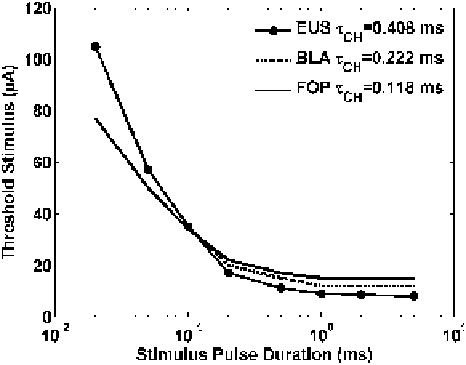Information Technology Reference
In-Depth Information
Fig. 13.1: Firing threshold of the external urethral sphincter motoneuron (EUS), the
neuron innervating the bladder (BLA), and the fiber of passage in the white matter
(FOP) stimulated with bipolar stimulation as predicted by simulation techniques and
reported by McIntyre and Grill [99].
τ
CH
represents the calculated chronaxie of the
particular neuron).
13.3 Local Field Potentials
Measurable electrical phenomena that occur in the human body are due primarily to
the transport of charged ions across the membrane of neurons as they relay and pro-
cess information governing movement and perception. In particular, rapid changes
in membrane permeability occurring on a millisecond scale produce current spikes
or “action potentials” [9,65]. At the same time, thousands of synaptic junctions con-
tribute to the “postsynaptic potential” or subthreshold changes in the transmembrane
potential. Furthermore, random processes within the neuron membrane may cause
spontaneous events to occur in addition to synaptic stimuli [81].
The
local field potential
(LFP) is related to the aggregate of the electric fields
produced by individual neurons in the vicinity of the electrode within the dielectric
medium of brain tissue. Furthermore, it is known that the recorded signal is influ-
enced by a frequency filtering characteristic, so that only low-frequency elements of
neural activity such as postsynaptic potentials propagate beyond the immediate cel-
lular environment to produce measurable signals [11,10]. Also, characteristics of the
analog front-end recording apparatus performing DC bias stability and prefiltering
further modify the frequency band of the signal.
Bedard et al. [11, 10] have shown that the frequency-dependent attenuation
with distance can be explained by using a nonhomogeneous model of extracel-
lular dielectric properties that take into consideration the properties of neighbor-
ing neuron membranes. Also, at the macroscopic level, a comprehensive study
of dielectric properties of tissues in the range of 10 Hz-20 GHz was prepared by

